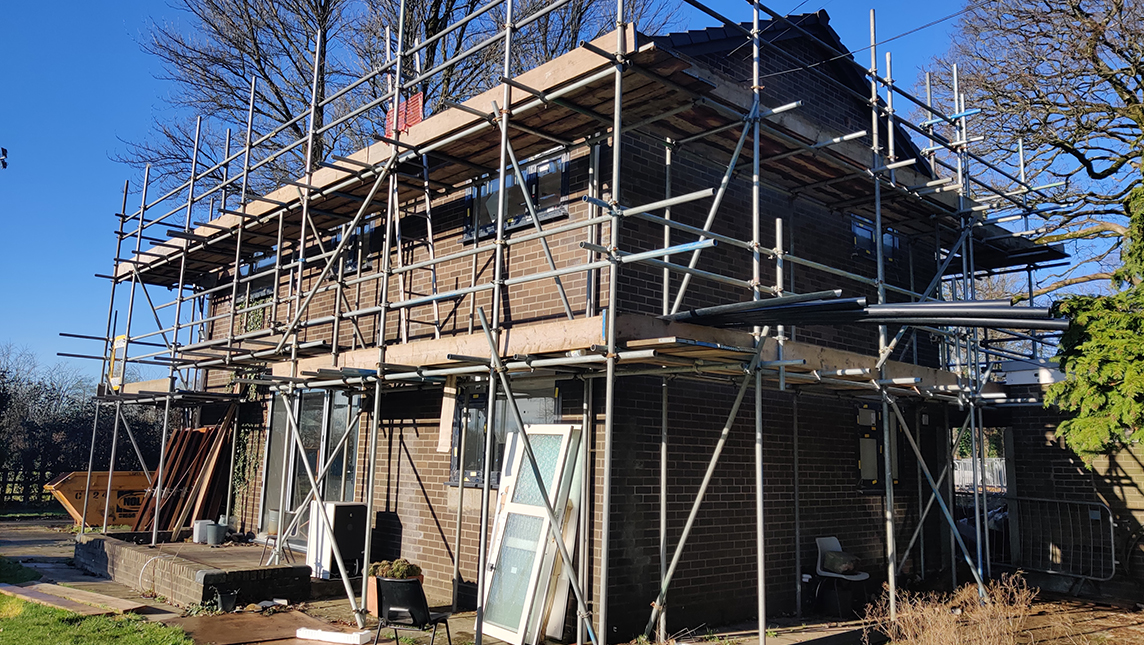
How a low carbon house conversion is set to become Bridgend College’s newest teaching space
Like many institutions across the education sector, Bridgend College has carbon net zero firmly on the agenda. The team has recently embarked on a project to retrofit a property on the Pencoed campus into a low carbon demonstration house.
Bridgend College puts a strong focus on sustainability and was recognised in the highly commended category at the 2022 Green Gown Awards for its zero emissions vision. A 1970’s property on their campus, originally home to the college principal, was no longer in use as a domestic residence and wasn’t energy efficient. The college was keen to use available Welsh Government funding to explore how this could be improved through a retrofit.

Head of curriculum, Rachel Edmonds-Naish also saw the project as an opportunity to create a space to teach students in a real domestic property instead of the existing workshop setting:
“As a college, we were already working in the green space and we wanted to explore that further with the type of training and upskilling we offer to our students. Our learners often go on to start work or take on apprenticeships within the housing sector, or with plumbing and building companies.
“We were delivering heat pump courses part-time and looking at the decarbonisation of heat, particularly in domestic properties, so when the house became available it seemed like the perfect opportunity to make use of it. The end goal was always to keep the house intact as a domestic property, to improve what was in there, and to use it as a teaching facility.”
Data in action
The retrofit project and the ongoing use of the house also offers a huge opportunity to capture valuable data. Having students learning in the property will allow the college to monitor the energy use and demonstrate the benefits of having energy efficient systems in place.
Unlike most domestic properties, the energy use in the house will be at peak consumption during the day, so the college is hopeful the data they gather will provide different insights to many of the scenarios modelled in standard homes. Welsh Government’s long-term ambition is to see around 30% of employees working from home, so data that could drive domestic energy savings will prove invaluable for this strategy and for housing considerations.
“Engagement with communities is one of the biggest challenges Welsh Government has, and it was strongly felt that this modelling of a house, with the data to share what the benefits are, would be a really good way to engage with the local population. People want to contribute to lowering carbon emissions but it’s often a long time before real results are seen on any investments, so to have data available will really help to showcase the potential benefits.”
The college approached Cardiff University’s Welsh School of Architecture, who had previously worked on low carbon housing projects and had a number of homes already modelled and in use. Plans for the house also include using it as a facility where students with additional learning needs can gain independent living skills (ILS) in a realistic home setting. This came with its own challenges as the house would have to be adapted to cater for all possible needs and to be fully accessible in a way most homes aren’t required to be.
“We have 100 ILS students and the property has to work really well for them. We needed to install a lift, which wouldn’t normally be necessary in that sort of house, and we fitted rise and fall kitchens for the students to learn in. These challenges and how the team worked together only made the project more interesting to work on.”
Changing timescales
The biggest challenge once the project got underway came in the form of supply-chain issues, with timescales changing frequently when materials didn’t arrive on schedule. There was strong support from the college’s senior leadership team from the start and regular meetings allowed any problems to be managed in collaboration with them throughout.
Rachel says this is where their early-stage planning paid off:
“We spent a lot of time modelling the house before we put down the specifics of the final plan. It takes longer than you think to get all the information you need about an older property. With any project you just want to get a spade in the ground and get started, but the time you spend preparing is always an investment, no matter how frustrating it is.
"I would also say - allow more time than you think you’ll need as there’s always something you didn't anticipate, especially on a large scale retrofit like this.”
With the house almost completed and ready for students to use, the focus is switching to the long-term plans to make the most of the property. The college hopes to build on its partnership with Cardiff University and explore how its students can work with undergraduate architecture students to gain work experience on live projects. A heat pump model will also be installed on site with QR codes included to link to further training information. The next phase of the project will see the garage used as a charging point model for electric vehicle engineering students, which Rachel says will benefit yet another curriculum area.
“Generally speaking, learners feel really proud when they have a high quality resource like this. We’ve really seen how engaged our engineering students are in the project because this amazing building will belong to them and has been provided for their learning. It really lifts them and gives them a sense of pride in where they study, which helps their motivation and makes them want to talk to other people about it. So the overall benefits for the learners and the college are really clear.”
Looking further ahead, following the opening of its STEAM Academy in 2021, plans are in place for a new town centre campus, part funded by Welsh Government’s sustainable communities for learning programme. The new, net zero carbon building will feature a sustainable garden with a sensory area and an outdoor eating space covered by a sedum green roof. An IT sustainability strategy is in progress to ensure the college’s carbon digital footprint is also on the agenda. With a long-term plan to reach a 100% reduction in emissions by 2040, the college is well on the way to meeting this target.